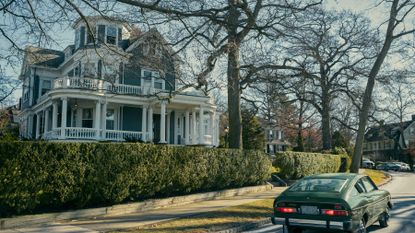

The premise of Netflix's 2022 true crime drama, The Watcher, comes straight from every homebody's nightmares: A family who just moved into their suburban dream home begins receiving anonymous letters, from a malicious voyeur called The Watcher. The miniseries is both frustrating and engrossing, as fictional couple Nora and Dean Brannock (played by Naomi Watts and Bobby Cannavale) slowly descend into paranoia and question everyone around them. And the fact that The Watcher existed in real life brings the scenario to another level of creepy.
The show is based on the 2018 New York Magazine article The Haunting of a Dream House, which tells the story of Maria and Derek Broaddus' (the IRL Brannocks') saga with 657 Boulevard. Several details from the real events make it into the show, including the names for the house address and the city of Westfield, New Jersey. However, the show did make a lot of changes in fictionalizing the true crime. Here's our breakdown parsing out the fact and the fiction (including who bought the house after the Broadduses).
What's the true story behind 'The Watcher'?
In June 2014, before Derek and Maria Broaddus (the real-life inspiration for the Brannocks) could even move into their new home in Westfield, New Jersey, the couple began receiving anonymous letters from someone called The Watcher. The letter was addressed to the new owners of 657 Boulevard, letting them know that generations of the writer's family have watched over the home since the 1920s, and that they have been put in charge of "waiting for its second coming." The Watcher also scolded the couple for starting renovations (the reason they had yet to move in), and threatened to kidnap their three children.
After alerting the police about the letter, the Broadduses learned that the previous owners of the home also received an anonymous letter before they moved out. The note was written by someone who said they had been keeping a close eye on the house, but the couple had lived at 657 Boulevard for 23 years and had never received a letter before, so they assumed it was a prank and threw it out.
The Broadduses kept receiving letters and they got more and more creepy; they were now addressed by name (though The Watcher misspelled their surname) and they included several mentions of "what is in the walls" of the house. The Watcher also questioned why they had yet to move in, and was anxious for them to do so:
It has been years and years since the young blood ruled the hallways of the house. Have you found all of the secrets it holds yet? Will the young blood play in the basement? Or are they too afraid to go down there alone. I would [be] very afraid if I were them. It is far away from the rest of the house. If you were upstairs you would never hear them scream.
Surprisingly, the Broadduses never moved in after receiving letters referring to their children as "the young blood." They put the house back on the market after six months, but they were unable to find a buyer due to the creepy letters (the couple made a point to disclose the letters to anyone who seemed serious about the property). Over the next few years, they continued to try to sell to no avail; they even explored the option of selling their home as a tear down, but they quickly drew the ire of the Westfield Planning Board and local community.
After the contentious four-hour planning board meeting, in spring of 2016, the Broadduses found renters for the property, a brave family who didn't mind the letters (in real-life, only two had been sent at that point, back in 2014). However, shortly after the new family moved in, a third Watcher letter arrived and it was way more aggressive than the prior two. The writer complained about the media coverage of the letters (the saga had gotten to the press at that point), and applauded their neighbors, "my soldiers of the Boulevard" for stopping the tear down attempt. They even straight-up threatened revenge on the couple:
Stay In The Know
Marie Claire email subscribers get intel on fashion and beauty trends, hot-off-the-press celebrity news, and more. Sign up here.
Maybe a car accident. Maybe a fire. Maybe something as simple as a mild illness that never seems to go away but makes you fell sick day after day after day after day after day. Maybe the mysterious death of a pet. Loved ones suddenly die. Planes and cars and bicycles crash. Bones break.
In a genuine surprise, the renters didn't move out, and just asked the Broadduses to install more security cameras.
Over the years, there had been several suspects for who The Watcher could be. The police thought it was someone in the neighborhood from the beginning, initially looking into the next-door neighbor Michael Langford, who had lived there since the '60s and seemed to inspire the show character Jasper Winslow. (Langford was never arrested.) Another suspect was a man who played violent video games under the username The Watcher. When they later discovered the DNA on the envelope was female, they looked into Michael's sister Abby, a real estate agent, and even Maria Broaddus herself.
Meanwhile, the neighbors thought that the Broadduses sent the letters themselves, trying to get out of the sale after realizing they couldn't afford the home. In another detail from the show that had a real-life mirror, Derek admitted to New York Magazine that he sent anonymous letters to his neighbors who had bashed him on Facebook in 2017. Despite the years of investigations, the Watcher was never identified as of 2018 when the magazine article was published, and they still haven't been caught today.
What happened to 657 Boulevard?
The real-life 657 Boulevard is not the same home we see in the show. The sprawling mansion with a pool seen on Netflix is actually located in Westchester County, New York, where the series was filmed. The real house in Westfield, New Jersey, is a six-bed, three-bath shingle-style home (per the Westfield Historic Preservation Society) which was built in 1905.
Despite 657 Boulevard's sordid history, real estate waits for no man, and the Broadduses eventually did find a buyer for the home. In summer 2019, the couple sold 657 for $959,000, taking a loss after purchasing the home for more than $1.35 million in 2014. Per NY Mag, the couple left a photograph of The Watcher’s handwriting in case any new letters showed up, but as of October 11, 2022, none have.
Meanwhile, the Broadduses still live in Westfield, and they told the outlet that there are reminders of the Watcher saga all over town. They have turned down every offer for on-camera interviews, and ended up selling the rights to their story after the article came out in 2018, assuming that the saga would likely be told with or without their permission. (In 2016, Lifetime released a The Watcher movie that took so much artistic license the couple couldn't stop it.) The pair reportedly had two requests for the show's production team: don't use their names, and make the family look as little like theirs as possible (hence the Brannocks having two kids rather than three). They also suggested that the show could burn the house down, but by the end of the finale, it still stands. (Netflix renewed the series for a second season in November 2022.)
Is John Graff based on a true story?
Of the series' many potential subjects, one is actually based on a separate true crime story. In Episode 3 Dean meets "John," a mysterious building inspector who's way too interested with the struggles within his family and the house itself. Later on, private investigator Theodora Birch (Noma Dumezweni) tells the patriarch the story of John Graff, a former owner of 657 Boulevard who killed his entire family inside the grand house. We never learn the truth about the fake building inspector (it's one of the many storylines the show never answers), but we do know the history of John List, the convicted killer who inspired the character.
List lived in Westfield, New Jersey, three decades before his fictional counterpart did, moving to 431 Hillside Avenue—a 19-room Victorian mansion named Breeze Knoll—with his wife, mother, and three children in 1965. He was a devout Lutheran and Sunday school teacher, who eventually struggled to maintain employment and began stealing money from his mother's $200,000 savings account, per NJ.com.
On November 9, 1971, List murdered his whole family, fatally shooting them over the course of an afternoon. He shot his wife, Helen Morris Taylor, and his mother, Alma Barbara Florence List, first, and later his daughter Patricia and son Frederick when they came home from school. He then made lunch for himself and closed his and his mothers' bank accounts before attending his son John's soccer game. He shot John while driving home from the game. After arranging his family's bodies in sleeping bags, he cleaned the crime scenes and removed his photos from the house before fleeing. In a five-page letter to his pastor, which was found when the bodies were discovered a month later, List confessed that he saw too much evil in the world and killed his family to save their souls.
The story of John Graff in The Watcher plays out similarly, with the addition of the Watcher letters helping to drive Graff to madness. There is also no mention of List's 15-year-old daughter having a flirtation with her teacher, so that detail was likely added to draw a parallel to Dean's weird protectiveness over his own daughter. Though Graff was never found, List was eventually caught, after over a decade on the run.
What happened to John List?
After the murders, List lived under the name Robert P. Clark, eventually remarrying and finding work again as an accountant. He was finally arrested on June 1, 1989, in Richmond, Virginia, thanks to America's Most Wanted. List was the subject of an episode that included a clay bust sculpted by a forensic artist, who determined how the killer may have looked in older age. After seeing the show, a former neighbor of List alerted the authorities. List finally confessed to the murders on February 16, 1990, and was later convicted on of five counts of first degree murder on April 12. He died on March 21, 2008, at age 82.

Quinci LeGardye is a Contributing Culture Editor who covers TV, movies, Korean entertainment, books, and pop culture. When she isn’t writing or checking Twitter, she’s probably watching the latest K-drama or giving a concert performance in her car.
-
 Here’s Everything You’ll Want From Spring Edelman’s Sale
Here’s Everything You’ll Want From Spring Edelman’s SaleFrom sandals to pumps to sneakers, the footwear brand now has over 500 markdowns to shop.
By Lauren Tappan Published
-
 Zendaya Packs Eight Outfit Changes Into 48 Hours
Zendaya Packs Eight Outfit Changes Into 48 HoursAnd they all play with the 'Challengers' tennis theme, of course.
By Julia Gray Published
-
 Tiffany Haddish Says She's Been Diagnosed With Endometriosis and Has Experienced 8 Miscarriages
Tiffany Haddish Says She's Been Diagnosed With Endometriosis and Has Experienced 8 Miscarriages“The devil is real.”
By Danielle Campoamor Published